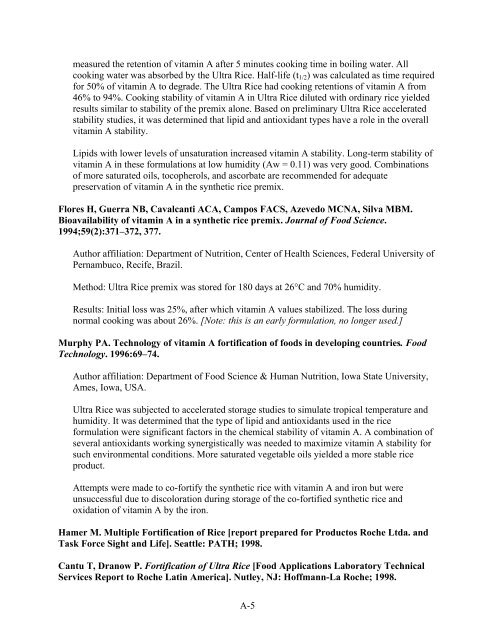The Research Behind the Ultra Rice® Technology - Path
The Research Behind the Ultra Rice® Technology - Path
The Research Behind the Ultra Rice® Technology - Path
You also want an ePaper? Increase the reach of your titles
YUMPU automatically turns print PDFs into web optimized ePapers that Google loves.
measured <strong>the</strong> retention of vitamin A after 5 minutes cooking time in boiling water. All<br />
cooking water was absorbed by <strong>the</strong> <strong>Ultra</strong> Rice. Half-life (t 1/2 ) was calculated as time required<br />
for 50% of vitamin A to degrade. <strong>The</strong> <strong>Ultra</strong> Rice had cooking retentions of vitamin A from<br />
46% to 94%. Cooking stability of vitamin A in <strong>Ultra</strong> Rice diluted with ordinary rice yielded<br />
results similar to stability of <strong>the</strong> premix alone. Based on preliminary <strong>Ultra</strong> Rice accelerated<br />
stability studies, it was determined that lipid and antioxidant types have a role in <strong>the</strong> overall<br />
vitamin A stability.<br />
Lipids with lower levels of unsaturation increased vitamin A stability. Long-term stability of<br />
vitamin A in <strong>the</strong>se formulations at low humidity (Aw = 0.11) was very good. Combinations<br />
of more saturated oils, tocopherols, and ascorbate are recommended for adequate<br />
preservation of vitamin A in <strong>the</strong> syn<strong>the</strong>tic rice premix.<br />
Flores H, Guerra NB, Cavalcanti ACA, Campos FACS, Azevedo MCNA, Silva MBM.<br />
Bioavailability of vitamin A in a syn<strong>the</strong>tic rice premix. Journal of Food Science.<br />
1994;59(2):371–372, 377.<br />
Author affiliation: Department of Nutrition, Center of Health Sciences, Federal University of<br />
Pernambuco, Recife, Brazil.<br />
Method: <strong>Ultra</strong> Rice premix was stored for 180 days at 26°C and 70% humidity.<br />
Results: Initial loss was 25%, after which vitamin A values stabilized. <strong>The</strong> loss during<br />
normal cooking was about 26%. [Note: this is an early formulation, no longer used.]<br />
Murphy PA. <strong>Technology</strong> of vitamin A fortification of foods in developing countries. Food<br />
<strong>Technology</strong>. 1996:69–74.<br />
Author affiliation: Department of Food Science & Human Nutrition, Iowa State University,<br />
Ames, Iowa, USA.<br />
<strong>Ultra</strong> Rice was subjected to accelerated storage studies to simulate tropical temperature and<br />
humidity. It was determined that <strong>the</strong> type of lipid and antioxidants used in <strong>the</strong> rice<br />
formulation were significant factors in <strong>the</strong> chemical stability of vitamin A. A combination of<br />
several antioxidants working synergistically was needed to maximize vitamin A stability for<br />
such environmental conditions. More saturated vegetable oils yielded a more stable rice<br />
product.<br />
Attempts were made to co-fortify <strong>the</strong> syn<strong>the</strong>tic rice with vitamin A and iron but were<br />
unsuccessful due to discoloration during storage of <strong>the</strong> co-fortified syn<strong>the</strong>tic rice and<br />
oxidation of vitamin A by <strong>the</strong> iron.<br />
Hamer M. Multiple Fortification of Rice [report prepared for Productos Roche Ltda. and<br />
Task Force Sight and Life]. Seattle: PATH; 1998.<br />
Cantu T, Dranow P. Fortification of <strong>Ultra</strong> Rice [Food Applications Laboratory Technical<br />
Services Report to Roche Latin America]. Nutley, NJ: Hoffmann-La Roche; 1998.<br />
A-5
















